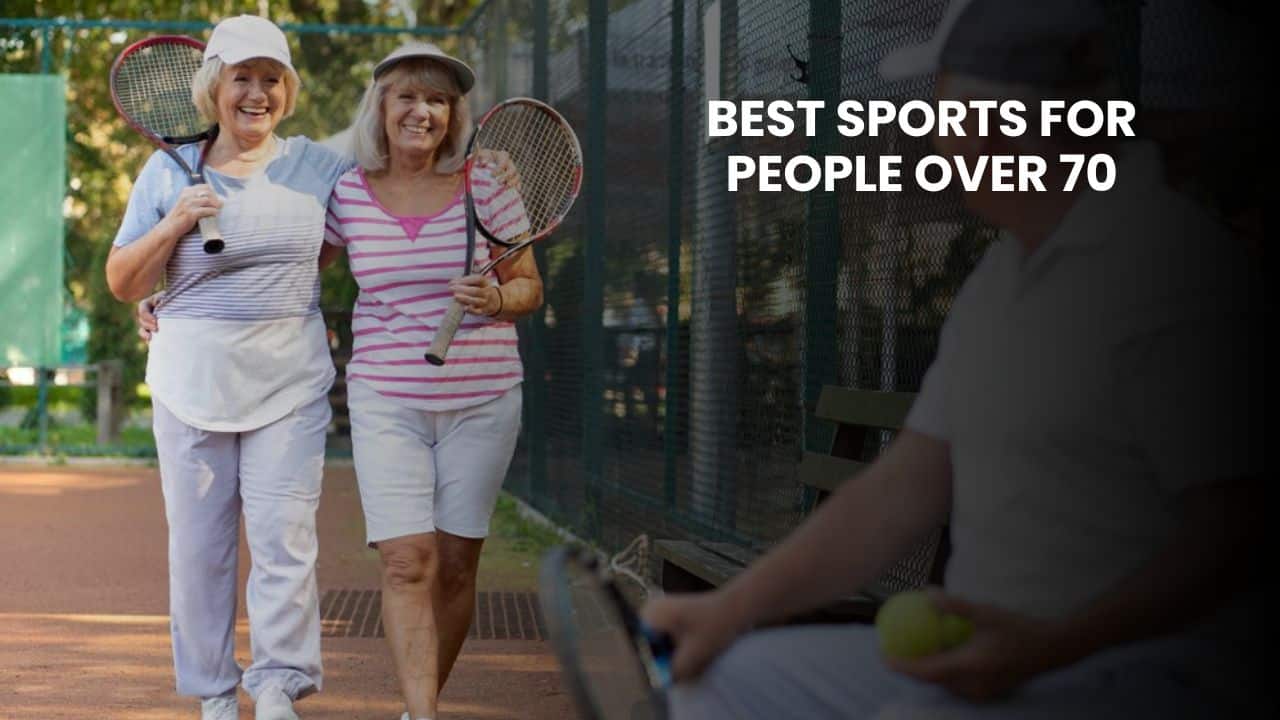Imagine waking up on your 70th birthday feeling energetic, strong, and ready to take on the world. Now picture yourself ten years later, still feeling that same vitality. Sounds too good to be true? It’s not! The secret to staying young well into your golden years isn’t found in a pill or a fancy cream – it’s in staying active and choosing the right sports.
In this article, we’ll explore the best sports for people over 70, diving into why they’re great choices and how to get started. We’ll also look at the amazing benefits of staying active, share some safety tips, and even peek at the latest research on exercise and aging. So, lace up your sneakers (or maybe just sit comfortably in your favorite chair for now), and let’s discover how you can stay young at heart – and in body – well past 70!
Why Stay Active After 70?
Before we jump into specific sports, let’s talk about why staying active is so crucial for older adults. Trust me, the benefits are pretty incredible:
1. Better heart health: Regular exercise keeps your heart strong and your blood flowing smoothly. It’s like giving your heart a friendly workout every day.
2. Stronger bones and muscles: As we age, we naturally lose some bone and muscle mass. But guess what? Exercise can slow this process down, keeping you stronger for longer.
3. Improved balance and flexibility: Ever worry about falls? Regular activity can make you steadier on your feet and more flexible, reducing the risk of trips and tumbles.
4. Sharper mind: Exercise isn’t just good for your body – it’s great for your brain too! It can help keep your mind sharp and may even lower the risk of cognitive decline.
5. More social connections: Many sports and activities are social affairs. They’re great opportunities to make new friends and keep in touch with old ones.
6. Lower risk of chronic diseases: Regular exercise can help prevent or manage conditions like diabetes, heart disease, and some types of cancer.
7. Better sleep: If you’ve been tossing and turning at night, exercise might be your ticket to dreamland. Regular activity can help you fall asleep faster and enjoy deeper, more restful sleep.
8. Happier mood: Exercise releases feel-good chemicals in your brain. It’s like a natural mood booster!
9. Increased independence: Staying active helps you maintain the strength and mobility you need for daily tasks, allowing you to live independently for longer.
10. Improved digestive health: Regular physical activity can help keep your digestive system running smoothly, reducing issues like constipation.
Now that we know why staying active is so important, let’s explore some of the best sports for people over 70.
Best Sports for People Over 70
1. Swimming
Swimming is like the superhero of sports for seniors. It’s gentle on your joints but gives your whole body a fantastic workout. Imagine gliding through the water, feeling weightless and free. That’s the joy of swimming!
Benefits:
– Builds muscle strength across your entire body
– Increases flexibility as you stretch through each stroke
– Boosts lung capacity and overall endurance
– Can help reduce blood pressure
How to start:
Find a local pool with senior-friendly hours or classes. Many community centers offer water aerobics or gentle swim classes for older adults. Start with simple water exercises or short swim sessions, gradually building up your time in the pool.
Pro tip: If you’re new to swimming or feeling unsure, consider taking a few lessons. A good instructor can help you perfect your technique and feel more confident in the water.
2. Walking
Walking might seem too simple to be called a sport, but don’t underestimate its power! It’s one of the most accessible and beneficial activities for seniors. Plus, it’s a great way to enjoy the outdoors and explore your neighborhood.
Benefits:
– Improves cardiovascular health with low impact on joints
– Strengthens legs, hips, and core muscles
– Helps maintain a healthy weight
– Can lower blood sugar levels
– Boosts mood, especially when done outdoors in nature
– Can be easily social when done with friends or in a walking group
How to start:
Begin with short walks around your neighborhood or in a local park. Start with 10-15 minutes and gradually increase your time and distance as you feel comfortable. Aim for a pace where you can still carry on a conversation but feel your heart rate increase slightly.
Pro tip: Invest in a good pair of walking shoes with proper support. Your feet will thank you!
3. Yoga
Yoga isn’t just for young, flexible folks – it’s a fantastic activity for seniors too! With its focus on gentle movements, breathing, and mindfulness, yoga offers a unique combination of physical and mental benefits.
Benefits:
– Improves flexibility and balance
– Reduces stress and promotes relaxation
– Strengthens muscles, particularly core muscles
– Can help manage chronic pain conditions
– Improves breathing and lung capacity
– Enhances mind-body connection
How to start:
Look for senior yoga classes at local community centers, gyms, or yoga studios. Many places offer chair yoga classes, which are great for those with balance concerns or limited mobility. Start with gentle or beginner classes and communicate any physical limitations to your instructor.
Pro tip: Don’t worry about touching your toes or doing complex poses. Yoga is about working with your body, not against it. Use props like blocks or straps to make poses more accessible.
4. Tai Chi
Often described as “meditation in motion,” Tai Chi is a gentle Chinese martial art that uses slow, flowing movements and deep breathing. It’s particularly beneficial for seniors due to its low-impact nature and focus on balance.
Benefits:
– Significantly improves balance and reduces fall risk
– Reduces stress and anxiety
– Enhances flexibility and strength
– Can lower blood pressure
– Improves sleep quality
– Boosts cognitive function
How to start:
Look for Tai Chi classes specifically designed for seniors. Many parks, community centers, and senior centers offer these classes. Start with beginner-level classes and focus on learning the basic movements before progressing to more complex forms.
Pro tip: Wear comfortable, loose-fitting clothes and flat shoes with thin soles to help you feel grounded during practice.
5. Golf
Golf isn’t just a game – it’s a great way for seniors to stay active, enjoy the outdoors, and socialize. Whether you’re walking the course or using a cart, golf provides a mix of gentle exercise and skill-based challenge.
Benefits:
– Provides moderate cardiovascular exercise, especially if you walk the course
– Improves hand-eye coordination
– Offers opportunities for social interaction
– Keeps the mind sharp through strategy and score-keeping
– Exposes you to vitamin D through sunlight (remember your sunscreen!)
– Can lower stress levels
How to start:
If you’re new to golf, consider taking beginner lessons at a local golf course or driving range. Many courses offer senior-friendly tee times and rates. Start with a few holes or at the driving range before attempting a full round.
Pro tip: Don’t feel pressured to walk the whole course right away. Using a golf cart is perfectly acceptable, especially when you’re starting out or on hot days.
6. Cycling
Cycling, whether outdoors or on a stationary bike, is an excellent low-impact cardiovascular exercise for seniors. It’s easy on the joints while providing an effective workout.
Benefits:
– Improves cardiovascular health
– Builds leg strength and endurance
– Low impact on joints, making it ideal for those with arthritis
– Can improve balance and coordination
– Boosts mood and reduces stress
– Can be done indoors or outdoors
How to start:
If balance is a concern, start with a stationary bike at home or at a gym. For outdoor cycling, begin on flat, quiet paths or trails. Consider a recumbent bike for added back support or a tricycle for improved stability.
Pro tip: Adjust your bike properly to ensure comfort and prevent strain. A local bike shop can help with fitting, or you can find guides online for proper bike setup.
7. Dancing
Who says exercise can’t be fun? Dancing is a joyful way to stay active, combining physical movement with social interaction and cognitive engagement.
Benefits:
– Improves cardiovascular health
– Enhances balance, coordination, and flexibility
– Boosts mood and reduces depression
– Provides social interaction
– Keeps the mind sharp through learning and remembering steps
– Can improve bone density
How to start:
Look for senior dance classes at community centers or dance studios. Many places offer classes in ballroom dancing, line dancing, or even Zumba Gold (a lower-impact version of Zumba designed for older adults). Start with beginner classes and progress at your own pace.
Pro tip: Don’t worry about having a partner or previous dance experience. Many classes are designed for individuals and absolute beginners.
8. Bowling
Bowling is a fun, social sport that can be enjoyed year-round. It’s particularly great for seniors because it can be adapted to different physical abilities.
Benefits:
– Improves arm strength and flexibility
– Enhances hand-eye coordination
– Provides gentle exercise through walking and lifting
– Offers social interaction
– Can be played seated for those with mobility issues
– Engages the mind through strategy and score-keeping
How to start:
Visit a local bowling alley during off-peak hours to get comfortable with the game. Many alleys offer senior leagues or discounted rates for seniors. Start with a lighter ball and focus on your form rather than power.
Pro tip: Most bowling alleys offer adaptive equipment for those with physical limitations, such as ball ramps for wheelchair users.
Safety Tips for Senior Athletes
While staying active is crucial, safety should always be your top priority. Here are some important tips to keep in mind:
1. Get a medical check-up: Before starting any new sport or exercise program, consult with your doctor. They can advise you on any precautions you should take based on your individual health status.
2. Start slow and build gradually: Rome wasn’t built in a day, and neither is fitness. Start with short sessions and gradually increase duration and intensity as you feel comfortable.
3. Listen to your body: Some muscle soreness is normal when starting a new activity, but pain is not. If something hurts, stop and rest.
4. Stay hydrated: Drink water before, during, and after exercise. Don’t wait until you feel thirsty.
5. Wear proper gear: Use appropriate, well-fitting equipment for your chosen sport. This includes supportive shoes and any necessary protective gear.
6. Warm up and cool down: Always start with a gentle warm-up to prepare your body for activity, and end with a cool-down to gradually return your heart rate to normal.
7. Exercise with a buddy: When possible, exercise with a friend or in a group. It’s safer and more fun!
8. Be aware of your environment: If exercising outdoors, be mindful of uneven surfaces, traffic, and weather conditions.
9. Don’t overdo it: It’s better to do a little bit consistently than to overexert yourself and risk injury.
10. Use proper technique: If you’re unsure about how to perform an exercise or use equipment correctly, ask for help from a trainer or instructor.
How Often Should Seniors Exercise?
Now that we’ve covered the “why” and “what” of exercise for seniors, let’s talk about the “how much.” The Centers for Disease Control and Prevention (CDC) provides these guidelines for older adults:
- Aerobic activity: Aim for at least 150 minutes of moderate-intensity aerobic activity per week. This could be 30 minutes a day, 5 days a week. Or, if you prefer, you can do 75 minutes of vigorous-intensity aerobic activity per week.
- Muscle-strengthening activities: Engage in activities that strengthen your muscles at least 2 days a week. This could include lifting weights, using resistance bands, or doing bodyweight exercises like push-ups or squats.
- Balance training: Incorporate activities that improve balance 3 or more days a week. This is especially important for reducing fall risk.
Remember, these are guidelines, not strict rules. The most important thing is to move more and sit less. If you’re not currently active, start with short amounts of activity and gradually build up. Any amount of exercise is better than none!
Overcoming Common Barriers to Exercise
Even knowing all the benefits, many seniors face challenges when it comes to staying active. Let’s look at some common barriers and how to overcome them:
1. Fear of injury: Start with low-impact activities and proper instruction. Remember, the risk of injury from inactivity is often greater than the risk from gentle exercise.
2. Lack of energy: It might seem counterintuitive, but regular exercise actually boosts energy levels over time. Start small and you’ll likely find your energy improving.
3. Chronic health conditions: Work with your doctor to find safe activities. Many chronic conditions actually improve with appropriate exercise.
4. Lack of motivation: Find a workout buddy or join group classes for support and accountability. Set small, achievable goals to keep yourself motivated.
5. Limited mobility: There are many seated exercises and adaptive sports available. A physical therapist can help you find appropriate activities.
6. Lack of time: Remember, even short bursts of activity throughout the day can add up. Try integrating exercise into your daily routine, like taking the stairs instead of the elevator.
7. Cost: Many community centers offer free or low-cost classes for seniors. Walking and home exercises can also be done at no cost.
8. Feeling too old: You’re never too old to start! There are people in their 90s and beyond staying active and reaping the benefits.
The Social Benefits of Sports for Seniors
Staying active isn’t just about physical health. The social aspects of sports and exercise can be just as beneficial for overall well-being. Here’s why:
- Meet new people: Joining a class or sports team is a great way to make new friends with similar interests.
- Spend quality time with family: Many sports, like golf or swimming, can be enjoyed with children and grandchildren.
- Combat loneliness: Regular group activities provide consistent social interaction, which is crucial for mental health.
- Share experiences: Bonding over shared activities can lead to deeper, more meaningful relationships.
- Develop a support network: Fellow exercisers can become a support system, encouraging you to stay active and healthy.
- Boost confidence: Mastering new skills and seeing physical improvements can significantly boost self-esteem.
- Stay connected to your community: Participating in local sports or fitness classes helps you stay engaged with your community.
Nutrition for Senior Athletes
Proper nutrition goes hand in hand with exercise for maintaining health and energy levels. Here are some key points to keep in mind:
- Stay hydrated: Drink plenty of water throughout the day, not just during exercise. Dehydration can be more common and more dangerous for older adults.
- Eat plenty of fruits and vegetables: These provide essential vitamins, minerals, and antioxidants to support your active lifestyle.
- Include lean proteins: Protein is crucial for maintaining muscle mass. Good sources include fish, lean meats, beans, and Greek yogurt.
- Choose whole grains: These provide sustained energy and important nutrients. Opt for brown rice, whole wheat bread, and oatmeal.
- Don’t forget healthy fats: Foods like avocados, nuts, and olive oil provide important nutrients and help you feel satisfied.
- Consider calcium and vitamin D: These nutrients are crucial for bone health. If you’re not getting enough from your diet, talk to your doctor about supplements.
- Eat balanced meals: Try to include a mix of carbohydrates, proteins, and fats at each meal for sustained energy.
- Listen to your body: Eat when you’re hungry and stop when you’re satisfied. As we age, our calorie needs may decrease, but our nutrient needs often increase.
Takeaway
Staying active after 70 is not just possible, it’s essential for maintaining health and quality of life. By choosing the right sports and activities, seniors can enjoy physical, mental, and social benefits. Remember to start slowly, prioritize safety, and most importantly, have fun. It’s never too late to embrace an active lifestyle and enjoy the many rewards it brings.
Whether you prefer the gentle movements of yoga, the social aspect of golf, or the cardiovascular benefits of swimming, there’s a sport out there for every senior. So why wait? Take that first step towards a more active, healthier you today.











































